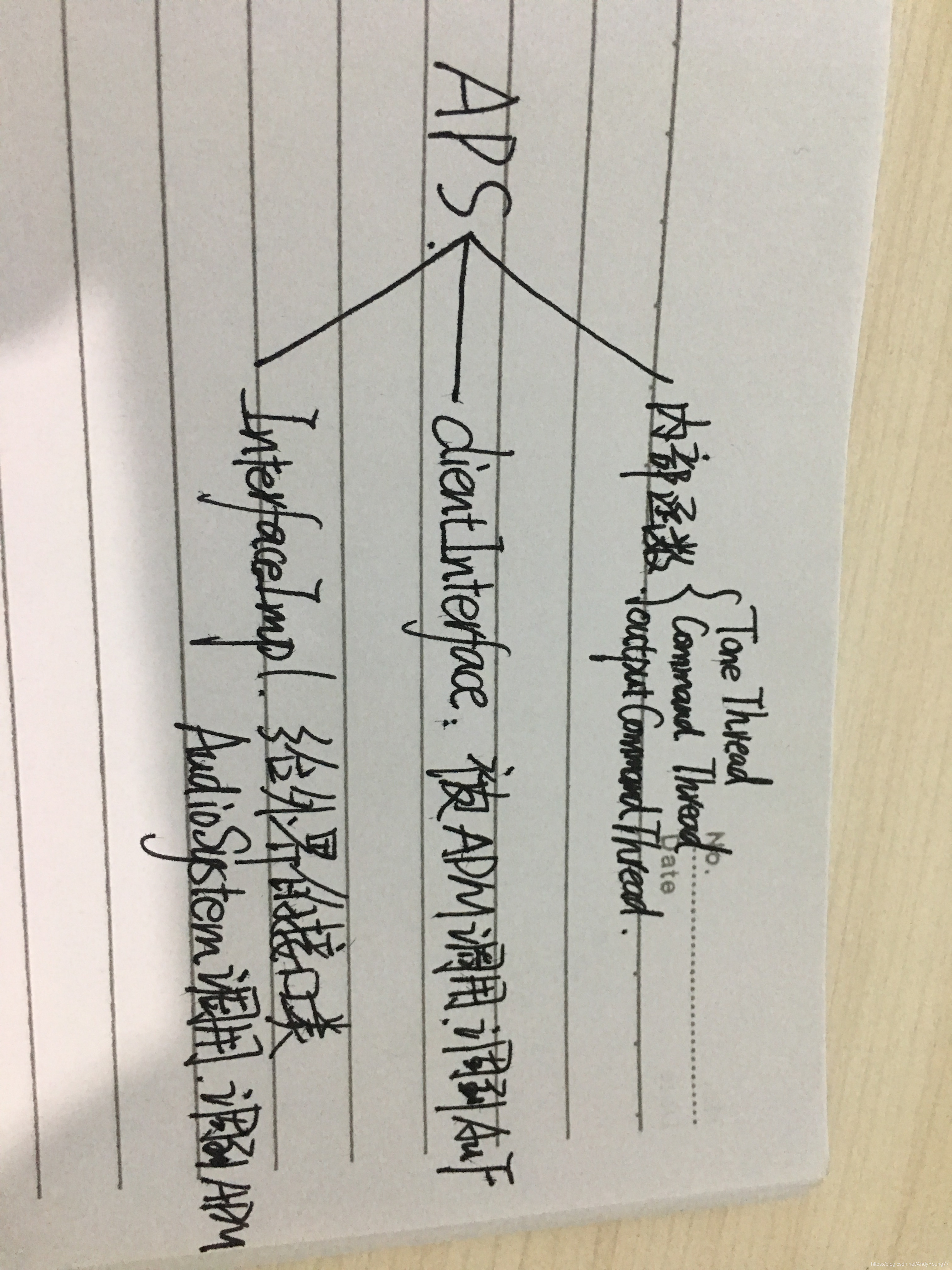APM和APS,你中有我,我中有你的关系。
1.AudioPolicyService 在AudioServer的onFirstRef中产生,类中有一个指针指向AudioPolicyManager,AudioPolicyInterface *mAudioPolicyManager; mAudioPolicyClient = new AudioPolicyClient(this); mAudioPolicyManager = createAudioPolicyManager(mAudioPolicyClient);//创建APM实例 看代码:
void AudioPolicyService::onFirstRef() { { Mutex::Autolock _l(mLock); // start tone playback thread mTonePlaybackThread = new AudioCommandThread(String8("ApmTone"), this); // start audio commands thread mAudioCommandThread = new AudioCommandThread(String8("ApmAudio"), this);//上层通过mAudioCommandThread setParameter就是这个thread // start output activity command thread mOutputCommandThread = new AudioCommandThread(String8("ApmOutput"), this); mAudioPolicyClient = new AudioPolicyClient(this); mAudioPolicyManager = createAudioPolicyManager(mAudioPolicyClient);//创建APM实例 } // load audio processing modules sp<AudioPolicyEffects>audioPolicyEffects = new AudioPolicyEffects(); { Mutex::Autolock _l(mLock); mAudioPolicyEffects = audioPolicyEffects; } }1.创建了2个线程,2.创建AudioPolicyManager并将其被指向的指针保存于自身类中。
AudioPolicyService存在于3个文件中,一个是AudioPolicyService.cpp,另外一个是AudioPolicyClientImpl.cpp中,最后是AudioPolicyInterfaceImpl.cpp。
主要以AudioCommandThread为最重要 bool AudioPolicyService::AudioCommandThread::threadLoop() 这个线程里面主要处理如下几个东西
AudioCommandThread::startToneCommand AudioCommandThread::volumeCommand AudioCommandThread::parametersCommand AudioCommandThread::stopOutputCommand AudioCommandThread::createAudioPatchCommand
这些是音量,setParameter和tone的控制部分。 举个栗子:
int AudioPolicyService::setStreamVolume(audio_stream_type_t stream, float volume, audio_io_handle_t output, int delayMs) { return (int)mAudioCommandThread->volumeCommand(stream, volume, output, delayMs); } status_t AudioPolicyService::AudioCommandThread::volumeCommand(audio_stream_type_t stream, float volume, audio_io_handle_t output, int delayMs) { sp<AudioCommand> command = new AudioCommand(); command->mCommand = SET_VOLUME; sp<VolumeData> data = new VolumeData(); data->mStream = stream; data->mVolume = volume; data->mIO = output; command->mParam = data; command->mWaitStatus = true; ALOGV("AudioCommandThread() adding set volume stream %d, volume %f, output %d", stream, volume, output); return sendCommand(command, delayMs); } bool AudioPolicyService::AudioCommandThread::threadLoop() { case SET_VOLUME: { VolumeData *data = (VolumeData *)command->mParam.get(); ALOGV("AudioCommandThread() processing set volume stream %d, \ volume %f, output %d", data->mStream, data->mVolume, data->mIO); command->mStatus = AudioSystem::setStreamVolume(data->mStream, data->mVolume, data->mIO); }break; }这部分是通过调用AudioFlinger来实现的 举个栗子
audio_module_handle_t AudioPolicyService::AudioPolicyClient::loadHwModule(const char *name) { sp<IAudioFlinger> af = AudioSystem::get_audio_flinger(); if (af == 0) { ALOGW("%s: could not get AudioFlinger", __func__); return AUDIO_MODULE_HANDLE_NONE; } return af->loadHwModule(name); }看到AudioPolicyClient有没有想起来什么很像的东西,对了,就是前面的mpClientInterface,那么看起来这个是APM调用过来的,经过APS到AudioFlinger
AudioPolicyClientImpl.cpp,这里面的是从IAudioPolicyService.cpp继承过来的虚接口,是实现类,也是AudioPolicyService对外提供的接口,这部分通过APS直接调用到APM,AudioSystem通过获取APS的client端的接口可以直接调用到native的APS,然后调用下来,前面说的那些thread就没法调用到,因为没有接口提供给外面,都是内部使用的。
举个栗子
status_t AudioSystem::setDeviceConnectionState(audio_devices_t device, audio_policy_dev_state_t state, const char *device_address, const char *device_name) { const sp<IAudioPolicyService>& aps = AudioSystem::get_audio_policy_service(); const char *address = ""; const char *name = ""; if (aps == 0) return PERMISSION_DENIED; if (device_address != NULL) { address = device_address; } if (device_name != NULL) { name = device_name; } return aps->setDeviceConnectionState(device, state, address, name); } AudioPolicyInterfaceImpl.cpp中 status_t AudioPolicyService::setDeviceConnectionState(audio_devices_t device, audio_policy_dev_state_t state, const char *device_address, const char *device_name) { Mutex::Autolock _l(mLock); return mAudioPolicyManager->setDeviceConnectionState(device, state, device_address, device_name); } status_t AudioPolicyManager::setDeviceConnectionState(audio_devices_t device, audio_policy_dev_state_t state, const char *device_address, const char *device_name) { return setDeviceConnectionStateInt(device, state, device_address, device_name); }以上就是APS的总结,顺便把APM也给说了,画一张图看起来比较清楚。
